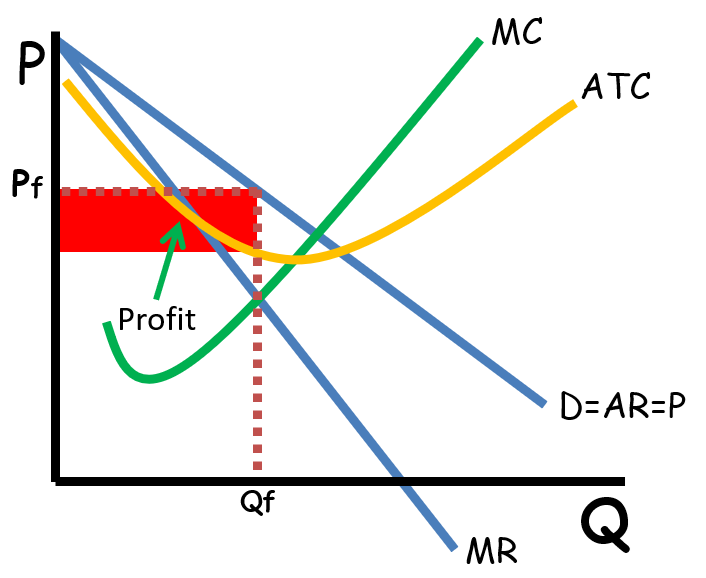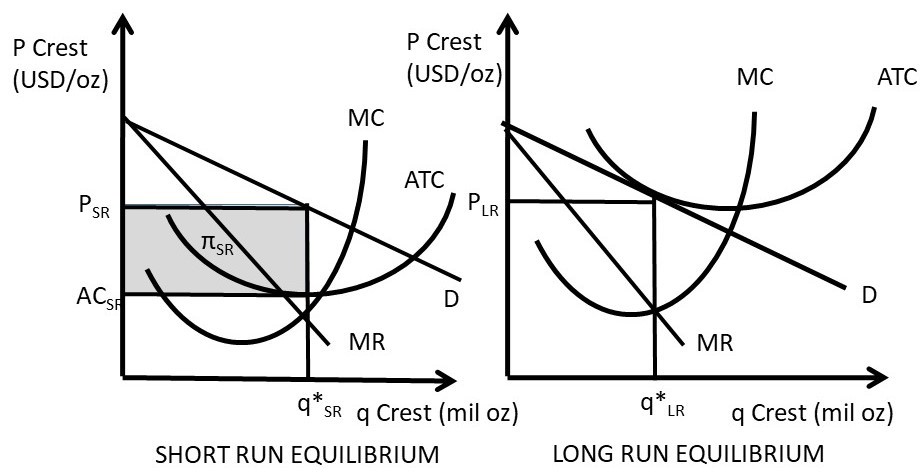Monopolistic competition is like a monopoly but also like competition. The main qualities are:
- Many sellers (lots of competition)
- Low barriers to entry (no long-run economic profit)
- Differentiated goods (downward-sloping demand curve, because of the substitution effect)
- Firms are price makers (raising prices will reduce quantity, but might increase profit)
Monopolistic competition curves show the firm’s demand curve, not the entire market’s.
Short-Run Long-Run Monopolistic Competition
In the short-run, monopolistic competition can yield an economic profit for a firm. Their graphs are identical to those of monopolies. The profit-maximizing and equilibrium quantity will be where . The equilibrium price will be where this quantity meets the demand curve. If the firm is earning an economic profit, the ATC will be placed below the profit-maximizing point and quantity; otherwise, it will be above the profit-maximizing point. Just like we learned in shutdown rule, a firm operating at a loss will continue to run until .

Long-Run Monopolistic Competition
In the long run, there must not be any economic profit. As a result, demand will rise/fall such that the ATC intersects the demand curve at the profit-maximizing quantity. In long-run monopolistic competition, the ATC must never fall below the demand curve. As a result, there is no economic profit in the long run. This distinction between short-run and long-run monopolistic competition is shown in the graph below:

Short-Run to Long-Run Shifts
Initially, if a monopolistically competitive firm is operating at a profit, other firms will enter the market and increase close substitutes within the market. As a result, demand and marginal revenue will shift to the left, to a point which is tangent to the average total curve. Now, the firm is break-even and running at normal profit. Keep in mind that the increase in substitutes will also make the demand curve more elastic.
Similarly, if a monopolistically competitive firm is operating at a loss, firms will leave the market and decrease close substitutes within the market. As a result, demand and marginal revenue will shift to the right, to a point which is tangent to the average total cost curve. Now, the firm is break-even and running at normal profit.
Efficiency
Monopolistically competitive firms are NOT productively efficient as they produce at the downward-sloping section of the ATC, which is considered excess capacity. This is known as economies of scale, as the monopoly ATC is equal to the long-run ATC. Essentially, firms can reduce the average cost of production by selling more, which monopolies are not doing by positioning at the profit-maximizing point.
Monopolistically competitive firms are also NOT allocatively efficient as they price above the marginal cost curve. The difference between the profit-maximizing point and the marginal cost is referred to as “markup”. If they were allocatively efficient, they would produce where the price is equal to the marginal cost, as this is where marginal benefit is equal to the marginal cost. Since monopolistically competitive firms are NOT allocatively efficient, they will operate with dead-weight loss.
Regardless, the benefit of monopolistic competition is the variety of goods we receive. Chocolate would be boring if they were all identical substitutes.
Cost Changes
A change in fixed cost will shift the ATC curve. A change in variable cost will shift both the ATC and the MC curve. This will shift the profit-maximizing point and the profit-maximizing quantity. Remember that this is only in the short-run as monopolistic competition always breaks even in the long run.